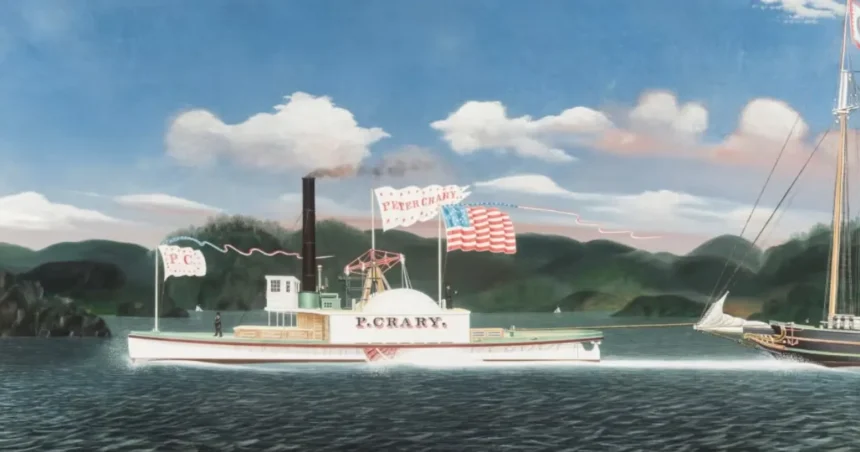Imagine a time when rivers were the highways of the world, and the fastest way to travel or move goods was by the power of wind or muscle. Then, along came the steamboat—a game-changer that transformed how people lived, worked, and connected. The steamboat’s popularity in the early 19th century didn’t just make travel faster; it reshaped economies, cultures, and even the landscapes of entire nations. In this article, we’ll dive into the incredible effects of the steamboat’s rise to fame, exploring how it revolutionized transportation, trade, and society in ways that still echo today. Whether you’re a history buff or just curious, let’s take a friendly journey back in time to see how this puffing, steam-powered marvel changed the world.
The Dawn of the Steamboat Era
Before the steamboat, moving goods or people along rivers was a slow and grueling task. Boats relied on sails, oars, or the current, which meant unpredictable schedules and long delays. Enter the steamboat, a vessel powered by a steam engine that could chug along rivers with reliability and speed. The first commercially successful steamboat, Robert Fulton’s Clermont, made its historic trip up the Hudson River in 1807, and from there, the steamboat craze took off like wildfire.
By the 1820s and 1830s, steamboats were a common sight on rivers across the United States, Europe, and beyond. Their ability to travel upstream against strong currents made them a sensation. But what exactly did this popularity mean for the world? Let’s break it down.
Economic Boom: Trade and Commerce on Steroids
One of the biggest effects of the steamboat’s popularity was an explosion in trade and commerce. Rivers like the Mississippi, Ohio, and Missouri became bustling arteries of economic activity. Here’s how steamboats fueled this boom:
-
Faster Transportation: Steamboats could carry goods and people much faster than traditional boats. A trip that once took weeks by flatboat could now be done in days. This speed meant merchants could sell fresh produce, textiles, and other goods before they spoiled or went out of style.
-
Lower Costs: Before steamboats, shipping goods upstream was expensive and labor-intensive. Steamboats slashed transportation costs, making it affordable to move heavy loads like cotton, grain, and timber. This opened up new markets and lowered prices for consumers.
-
Regional Connections: Steamboats linked rural areas to urban centers. Farmers in the Midwest could now ship their crops to cities like New Orleans or St. Louis, turning small towns into economic hubs. This connectivity helped regions specialize in what they produced best, boosting overall prosperity.
-
Industrial Growth: The demand for steamboats spurred industries like iron production (for engines) and lumber (for boat construction). Shipyards popped up along rivers, creating jobs and fueling the Industrial Revolution.
In short, steamboats turned rivers into superhighways of commerce, making trade faster, cheaper, and more widespread than ever before.
Social Impact: Bringing People Together
The steamboat wasn’t just about moving goods—it also brought people closer together. Its popularity reshaped how communities interacted and grew:
-
Migration Made Easier: Steamboats made it simpler for people to move westward in the United States. Settlers could travel comfortably and quickly to new territories, spurring the growth of frontier towns. This migration helped shape the American West, as families and adventurers flocked to places like Missouri and Illinois.
-
Cultural Exchange: As people traveled more, ideas, traditions, and cultures mixed. Steamboats carried immigrants, traders, and travelers who shared stories, music, and customs. Cities along rivers became melting pots, blending diverse influences into vibrant communities.
-
Tourism and Leisure: Steamboats weren’t just workhorses; they were also floating palaces for the wealthy. Luxurious steamboats with grand dining rooms and live music became popular for leisurely river cruises, giving rise to a new kind of tourism. Even ordinary folks could afford short trips, making travel a pastime for the masses.
The steamboat’s ability to connect people fostered a sense of unity and shared identity, knitting together far-flung communities in a way that was unthinkable before.
Environmental and Geographic Changes
The steamboat’s popularity didn’t just affect people and economies—it also left its mark on the land itself. Rivers and their surroundings were transformed to accommodate this new technology:
-
River Navigation Improvements: To keep up with steamboat traffic, governments and private companies invested in clearing rivers of snags, sandbars, and other obstacles. They also built canals and locks to make navigation smoother. These changes made rivers more reliable for transportation but altered their natural flow.
-
Urban Growth Along Rivers: Cities like Cincinnati, Memphis, and New Orleans exploded in size because of steamboat traffic. Ports and docks sprang up, turning sleepy riverbanks into bustling urban centers. This urbanization changed the landscape, as forests were cleared and infrastructure expanded.
-
Environmental Impact: Steamboats burned wood or coal, which led to deforestation along riverbanks as crews harvested fuel. The smoke from their engines also contributed to air pollution in busy ports. While these effects were small compared to modern industry, they were early signs of how technology could impact the environment.
The steamboat’s rise reshaped the geography of river regions, turning them into economic and social hotspots while leaving lasting environmental footprints.
Technological Advancements and Competition
The popularity of steamboats didn’t just change how things were done—it sparked a wave of innovation. Engineers and inventors worked tirelessly to make steamboats faster, safer, and more efficient. This led to:
-
Improved Designs: Early steamboats were clunky and prone to boiler explosions. As demand grew, engineers developed stronger engines, better hulls, and safety features like pressure valves. These advancements made steamboats more reliable and encouraged even wider use.
-
Competition with Railroads: By the mid-19th century, railroads began to challenge steamboats as a faster way to move goods and people. This competition pushed steamboat operators to innovate further, offering luxurious amenities or faster routes to stay competitive. While railroads eventually took over long-distance travel, steamboats remained vital for river transport.
-
Global Influence: The steamboat’s success wasn’t limited to the United States. In Europe, steamboats plied rivers like the Thames and the Rhine, while in Asia and Africa, they opened up trade routes along major waterways. This global adoption spread technological know-how and inspired local innovations.
The steamboat’s popularity drove a cycle of invention and competition that pushed technology forward, paving the way for the modern transportation systems we rely on today.
Challenges and Downsides
Of course, the steamboat’s rise wasn’t all smooth sailing. Its popularity brought challenges that affected society and the economy:
-
Safety Risks: Early steamboats were dangerous. Boiler explosions, fires, and collisions were common, claiming countless lives. The race to build faster boats sometimes led to cutting corners on safety, putting passengers and crew at risk.
-
Economic Inequality: While steamboats created wealth, not everyone benefited equally. Large merchants and steamboat operators grew rich, but smaller businesses struggled to compete. Workers on steamboats often faced harsh conditions and low pay.
-
Impact on Native Communities: In the United States, the steamboat’s role in westward expansion often came at the expense of Native American tribes. As settlers moved into new territories, they displaced indigenous peoples, leading to conflict and loss of land.
Despite these challenges, the steamboat’s benefits were undeniable, and its popularity continued to grow until newer technologies like railroads and steamships took center stage.
A Lasting Legacy
The steamboat’s heyday may have faded by the late 19th century, but its impact is still felt today. It laid the groundwork for modern transportation, showing the world what steam power could do. It connected people and places, fueled economic growth, and sparked innovations that shaped the Industrial Revolution. Even now, the romance of the steamboat lives on in river cruises, historical reenactments, and stories of a time when these mighty vessels ruled the waters.
Table: Key Effects of the Steamboat’s Popularity
|
Category |
Effect |
Description |
|---|---|---|
|
Economic Growth |
Increased Trade Volume |
Steamboats enabled faster and cheaper transport of goods, boosting markets and commerce. |
|
Lower Transportation Costs |
Reduced costs of shipping goods upstream made trade more affordable and accessible. |
|
|
Regional Economic Integration |
Connected rural areas to urban centers, fostering specialized economies and growth. |
|
|
Industrial Development |
Demand for steamboats spurred industries like iron and lumber, creating jobs. |
|
|
Social Impact |
Easier Migration |
Facilitated westward expansion in the U.S., leading to the growth of frontier towns. |
|
Cultural Exchange |
Brought diverse groups together, blending ideas and traditions in river cities. |
|
|
Rise of Tourism |
Luxurious steamboats made river travel a popular leisure activity for all classes. |
|
|
Environmental Changes |
River Navigation Improvements |
Cleared rivers and built canals/locks to support steamboat traffic, altering natural river systems. |
|
Urbanization Along Rivers |
Growth of port cities like New Orleans and Memphis transformed landscapes. |
|
|
Environmental Impact |
Deforestation and air pollution from steamboat fuel use affected riverbank ecosystems. |
|
|
Technological Advancements |
Improved Steamboat Designs |
Innovations in engines and safety features made steamboats more reliable. |
|
Competition with Railroads |
Pushed steamboat operators to innovate, maintaining their relevance for river transport. |
|
|
Global Spread of Technology |
Steamboats influenced transportation worldwide, spreading steam technology. |
|
|
Challenges |
Safety Hazards |
Boiler explosions and accidents posed risks to passengers and crew. |
|
Economic Inequality |
Wealth concentrated among large operators, leaving smaller businesses and workers behind. |
|
|
Impact on Native Communities |
Facilitated westward expansion, often displacing Native American tribes. |
Wrapping Up
an effect of the steamboat’s popularity was that more than a fleeting trend—it was a revolution that reshaped the world. From boosting trade to connecting cultures, it changed how people lived and worked in ways that were unimaginable before its invention. While it brought challenges, its legacy as a pioneer of modern transportation endures. So, the next time you see a river, picture those puffing steamboats gliding along, carrying dreams, goods, and a new era of progress. What an incredible ride it must have been!







